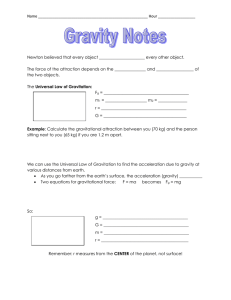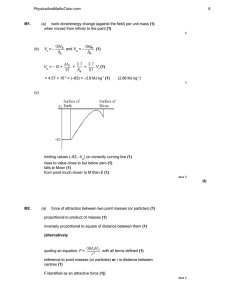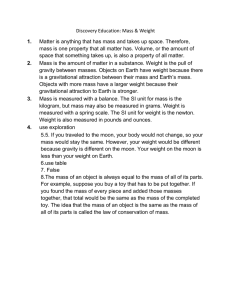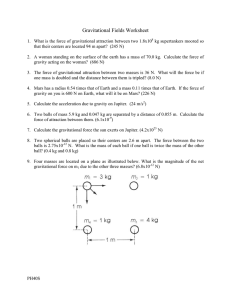Universal Gravitation
advertisement
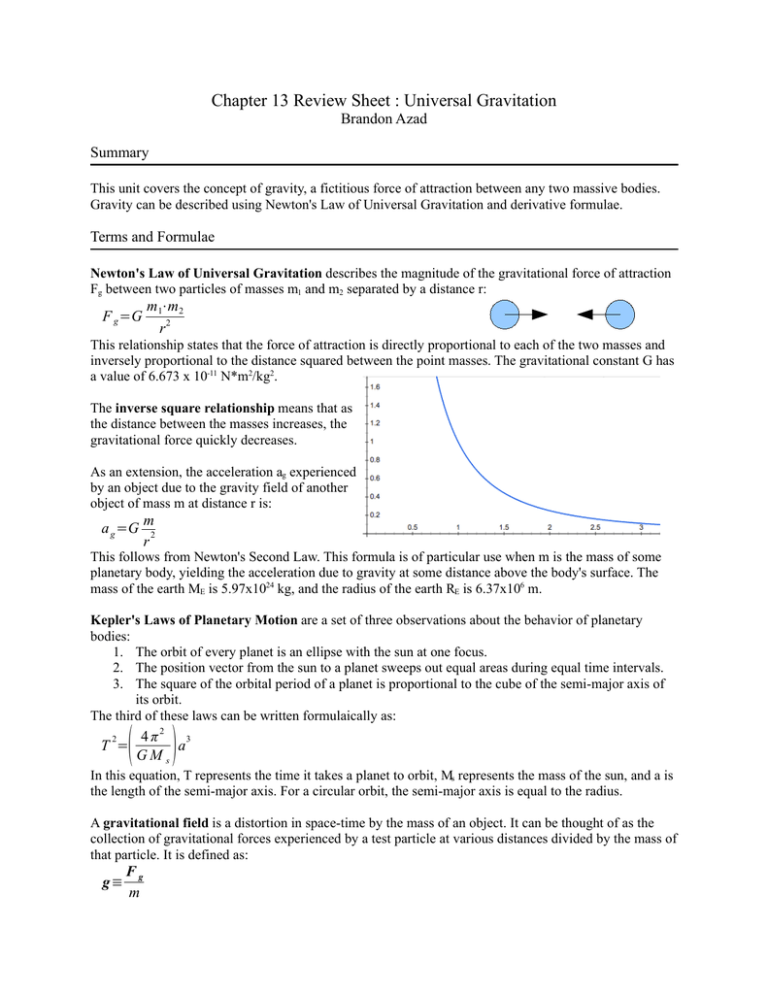
Chapter 13 Review Sheet : Universal Gravitation Brandon Azad Summary This unit covers the concept of gravity, a fictitious force of attraction between any two massive bodies. Gravity can be described using Newton's Law of Universal Gravitation and derivative formulae. Terms and Formulae Newton's Law of Universal Gravitation describes the magnitude of the gravitational force of attraction Fg between two particles of masses m1 and m2 separated by a distance r: F g =G m1⋅m2 r2 This relationship states that the force of attraction is directly proportional to each of the two masses and inversely proportional to the distance squared between the point masses. The gravitational constant G has a value of 6.673 x 10-11 N*m2/kg2. The inverse square relationship means that as the distance between the masses increases, the gravitational force quickly decreases. As an extension, the acceleration ag experienced by an object due to the gravity field of another object of mass m at distance r is: a g =G m 2 r This follows from Newton's Second Law. This formula is of particular use when m is the mass of some planetary body, yielding the acceleration due to gravity at some distance above the body's surface. The mass of the earth ME is 5.97x1024 kg, and the radius of the earth RE is 6.37x106 m. Kepler's Laws of Planetary Motion are a set of three observations about the behavior of planetary bodies: 1. The orbit of every planet is an ellipse with the sun at one focus. 2. The position vector from the sun to a planet sweeps out equal areas during equal time intervals. 3. The square of the orbital period of a planet is proportional to the cube of the semi-major axis of its orbit. The third of these laws can be written formulaically as: 2 ( ) T = 4 π2 3 a GMs In this equation, T represents the time it takes a planet to orbit, Ms represents the mass of the sun, and a is the length of the semi-major axis. For a circular orbit, the semi-major axis is equal to the radius. A gravitational field is a distortion in space-time by the mass of an object. It can be thought of as the collection of gravitational forces experienced by a test particle at various distances divided by the mass of that particle. It is defined as: g≡ Fg m In this formula, g represents the gravitational field (a vector quantity) at some point p at a distance r from the mass m, and Fg (another vector quantity) represents the attractive force between the two masses. This field is conservative. The gravitational potential energy U associated with two masses separated by a distance r is: U =−G m1 m2 r This formula assumes U to be zero at a distance of r = ∞. This relation can be summed over each pair of particles in a set to get the total gravitational potential energy of a system of particles. The change in potential energy as two point masses grow closer or farther apart can be expressed as the difference in potential energy between the final and initial states; this calculation yields the formula: ∆U =G m1 m2 ( r1 − r1 ) i f The total energy E of a planetary system (or any system where one body of mass m1 is moving with a velocity v around another body of mass m2) is: m m 1 E= m1 v 2−G 1 2 2 r This is the sum of the kinetic and gravitational potential energies. For a system where the mass m1 is orbiting elliptically around m2 with a semi-major axis a and when m2 >> m1, the total energy E is: E=−G m1 m2 2a The escape velocity from the surface of a planet (or other mass) of radius r and mass m is the initial radially outward velocity an object at the surface must have to completely escape the gravitational “pull” of the planet. This is equivalent to the minimum velocity needed for the object to reach an infinite distance from the planet, and can be calculated as: v esc = √ 2G m r Observations An important observation when dealing with a specific class of problems is that the gravitational field inside a hollow sphere is zero. This can be useful, for example, when plotting the strength of the gravitational field inside solid massive spheres. For any bound system, the total energy is negative. This can be seen from the second total energy equation above. Problems 1. [Easy] What is the acceleration of a meteorite due to the Earth's gravity at a distance of four Earth radii above the surface? 2. [Medium] Plaskett's binary system consists of two stars that revolve in a circular orbit about a center of mass midway between them. This means that the masses of the two stars are equal. Assume the orbital speed of each star is 220 km/s and the orbital period of each is 14.4 days. Find the mass M of each star. 3. [Hard] Astronomers detect a distant meteoroid moving along a straight line that, if extended, would pass at a distance 3RE from the center of the Earth, where RE is the Earth's radius. What minimum speed must the meteoroid have if the Earth's gravitation is not to deflect the meteoroid to make it strike the Earth? Leave your result in symbolic form. Solutions 1. At a distance of four radii above the surface of the earth, the force of gravity will be significantly less. Since we know radii and masses and we want accelerations, let's start with the acceleration equation. a g =G m 2 r Substitute our values (remember: 4 radii above Earth's surface is 5 radii from the center). ME ME =G 2 (4 R E + R E ) 25 R 2E ME 1 1 9.80 m/s 2 2 ag= G 2 = g= =0.392 m/ s 25 25 25 RE a g =G ( ) Acceleration due to gravity at four Earth radii is thus 1/25 that at the surface, or about 0.392 m/s2. 2. There is a single force acting on each body, that of gravity. Apply Newton's Second Law. The bodies are traveling in a circular path, so their acceleration is centripetal. F g =m a ; a= F g =M v2 r v2 r Evaluate the force of gravity using Newton's Law of Universal Gravitation. Note that the r in the formula is the distance between the two bodies, not the radius of their orbit. m1 m2 M2 F g =G 2 =G r (2 r)2 Combine the above equations. M2 v2 G 2 =M r 4r 2 4v r M= G R is unknown, so we must reexpress it in terms of a variable we do know, T. v T =2 π r 2 v3 T M= πG Substitute the given values. M= 2(220×103 m/s)3(14.4 days)(86400 s/ day) =1.26×1032 kg −11 2 2 π 6.67×10 N⋅m /kg Thus, the mass of each star is 1.26 x 1032 kg. 3. This problem is asking for the velocity at which the meteoroid will just graze the Earth; the meteoroid will miss at a velocity just greater than this. Because we're looking for a velocity consider solving the problem using energy analysis. U i + K i =U f +K f U gi+ K i =U gf + K f Assume the meteoroid has a mass m, initial velocity v0, and final velocity v. Assume as well that the meteoroid, at such a great initial distance, has zero gravitational potential energy with the Earth. mM E 1 1 0+ m v 02=−G + m v2 2 RE 2 M v 02=v 2−2G E RE There are two unknowns; we need to eliminate v. Since there is no torque acting on the meteoroid, consider its angular momentum about the Earth. L=r× p=r×m v Li = L f Because the meteoroid is on a linear path to a minimum distance of 3 Earth radii from the center of the Earth, we can evaluate the magnitude of its initial linear momentum as if it were at that minimum location. 3 R E m v0= R E m v 3v 0=v Plug this result into the equation above. v 02=(3v 0)2−2G ME RE ME 4 RE M v 0= G E 4 RE v 02=G √ Thus, the initial velocity must be greater than √ G ME 4 RE

